Overview of Igneous Rocks
3.2 IGNEOUS ROCK ORIGIN
3.2.1 Magma Composition
Before any igneous rock can form, there must be molten material, known as magma, produced; therefore, you must have a rock to melt to make the magma, which then cools to become an igneous rock. There are many factors which may affect the composition of the igneous rock, including the initial rock or rocks that melt to form the magma, the degree of melt, the cooling process of the magma, etc. These are things one should consider when studying the origin of igneous rocks.
Most rocks contain minerals that are crystalline solids composed of the chemical elements. All minerals have a certain set of conditions, such as temperature, at which they can melt; since rocks contain a mixture of minerals, some of the minerals in a rock may melt, while others remain solid. Temperature conditions are important, as only minerals that can melt at “lower” temperatures may experience melting, whereas the temperature would have to increase in order for other minerals to also melt and add their chemical components to the magma that is being generated. Therefore, if the same types of rocks are melting, different magma compositions are generated simply by melting at different temperatures!
Eventually, magma will start to rise upward through the Earth’s lithosphere, as it is more buoyant than its source rock. This separation of magma from source region will result in new thermal conditions, which results in the magma cooling. As with melting, minerals also have a certain set of conditions at which they form, or crystallize, from within a cooling magma body. The sequence of mineral crystallization is the opposite sequence of crystal melting, which had been experimentally determined by Norman L. Bowen in the early 1900’s, and known as Bowen’s reaction series (e.g. Figure 3.1)
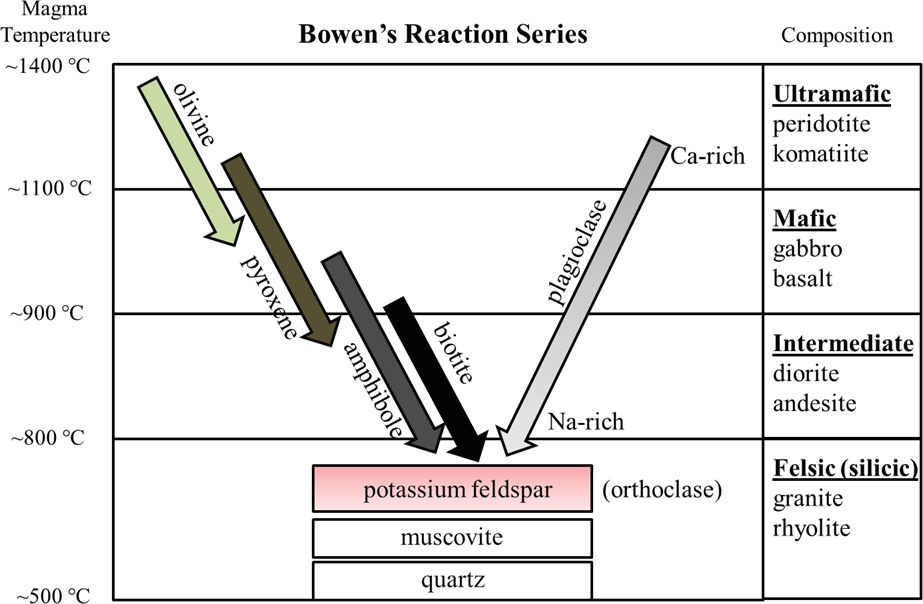
Source: Karen Tefend (2015) CC BY-SA 3.0 view source
This “reaction series” refers to the chemical reactions that are the formation of minerals, through chemical bonding of elements within the magma, in a sequence that is based on falling magma temperatures. Close examination of Figure 3.1 shows that the first mineral to crystallize in a cooling magma of ultramafic composition is olivine; the length of the arrow indicates the range of temperatures at which olivine can form. Once temperatures fall below this range, olivine crystals will no longer form; instead, other minerals such as pyroxene will start to crystallize (a small interval of temperatures exists where both olivine and pyroxene can crystallize). Minerals that form in cooling magma are called crystals, or phenocrysts; as these phenocrysts are forming, they are removing chemical elements from the magma. For example, olivine phenocrysts take magnesium (Mg) and iron (Fe) from the magma and incorporate them into their crystal structure. This behavior of mineral phenocrysts to take certain chemical elements into their structure, while excluding other elements, means that the composition of the magma must be changing as phenocrysts are forming!
There can be more than one mineral type crystallizing within the cooling magma, as the arrows in Figure 3.1 demonstrate. The minerals on the left side of Bowen’s reaction series are referred to as a discontinuous series, as these minerals (olivine, pyroxene, amphibole, and biotite) all remove the iron (Fe), magnesium (Mg), and manganese (Mn) from the magma during crystallization, but do so at certain temperature ranges. These iron- and magnesium-rich minerals are referred to as ferromagnesian minerals (ferro = iron) and are usually green, dark gray, or black in colour due to the absorption of visible light by iron and magnesium atoms. On the right side of Bowen’s reaction series is a long arrow labelled plagioclase feldspar. Plagioclase crystallizes over a large temperature interval and represents a continuous series of crystallization even though its composition changes from calcium (Ca) rich to sodium (Na) rich. As the magma temperature drops and plagioclase first starts to crystallize (form), it will take in the calcium atoms into the crystal structure, but as magma temperatures continue to drop, plagioclase takes in sodium atoms preferentially. As a result, the higher temperature calcium-rich plagioclase is dark gray in colour due to the high calcium content, but the lower temperature sodium-rich plagioclase is white due to the high sodium content. Finally, at the bottom of the graph in Figure 3.1, we see that three more minerals can form as temperatures continue to drop. These minerals (potassium feldspar, muscovite, and quartz) are considered to be the “low temperature minerals”, as they are the last to form during cooling, and therefore first to melt as a rock is heated. The previous removal of iron and magnesium from the magma results in the formation of the latest-forming minerals that are deficient in these chemical elements; these minerals are referred to as nonferromagnesian minerals, which are much lighter in colour. For example, the potassium-rich feldspar (also known as orthoclase) can be a pale pink or white in colour. The references to mineral colour are necessary, as the colour of any mineral is primarily due to the chemical elements that are in the minerals, and therefore the colour of an igneous rock will be dependent on the mineral content (or chemical composition) of the rock.
3.3 IGNEOUS ROCK COMPOSITION
Often added to the Bowen’s reaction series diagram are the igneous rock classifications as well as example igneous rock names that are entirely dependent on the minerals that are found in them. For example, you can expect to find abundant olivine, and maybe some pyroxene and Ca-rich plagioclase, in an ultramafic rock called peridotite or komatiite, or that pyroxene, plagioclase, and possibly some olivine or amphibole may be present in a mafic rock such as gabbro or basalt. You can also expect to see quartz, muscovite, potassium feldspar, and some biotite and Na-rich plagioclase in a felsic (or silicic) rock such as granite or rhyolite. Figure 3.1 demonstrates nicely that the classification of an igneous rock depends partly on the minerals that may be present in the rock, and since the minerals have certain colours due to their chemical makeup, then the rocks must have certain colours. For example, a rock composed of mostly olivine will be green in colour due to olivine’s green colour; such a rock would be called ultramafic. A rock that has a large amount of ferromagnesian minerals in it will be a dark-coloured rock because the ferromagnesian minerals (other than olivine) tend to be dark coloured; an igneous rock that is dark in colour is called a mafic rock (“ma-” comes from magnesium, and “fic” from ferric iron). An igneous rock with a large amount of nonferromagnesian minerals will be light in colour, such as the silicic or felsic rocks (“fel” from feldspar, and “sic” from silica-rich quartz). So, based on colour alone, we’ve been able to start classifying the igneous rocks.
Figure 3.2 shows examples of igneous rocks representing mafic and felsic rock compositions (Figures 3.2A and 3.2C, respectively), as well as an intermediate rock type (Figure 3.2B). Felsic rocks may have small amounts of dark-coloured minerals, but are predominately composed of light-coloured minerals, whereas mafic rocks have a higher percentage of dark-coloured minerals, which results in a darker-coloured rock. A rock that is considered intermediate between the mafic and felsic rocks is truly an intermediate in terms of the colour and mineral composition; such a rock would have less dark minerals than the mafic rocks, yet more dark minerals than the felsic rocks.

Source: Karen Tefend (2015) CC BY-SA 3.0 view source
As previously mentioned, classifying rocks into one of the igneous rock compositions (ultramafic, mafic, intermediate, and felsic) depends on the minerals that each rock contains. Identification of the minerals can be difficult in rocks such as in Figure 3.2A, as the majority of minerals are dark in colour and it can be difficult to distinguish each mineral. An easy method of determining the igneous rock composition is by estimating the percentage of dark-coloured mafic minerals in the rock, without trying to identify the actual minerals present; this method of classification relies on a mafic colour index (MCI), where the term mafic refers to any dark gray, black or green coloured mineral (Figure 3.3). Igneous rocks with 0-15% dark colored minerals (or 0-15% MCI) are the felsic rocks (Figure 3.3A), igneous rocks with 46-85% MCI are the mafic rocks (Figure 3.3C), and igneous rocks with over 85% MCI are considered ultramafic (Figure 3.3D). This means that any rock with an intermediate composition or with a 16-45% MCI is an intermediate igneous rock (Figure 3.3B). Estimating the amount of mafic minerals is only possible if the minerals are large enough to see; in that case, a person can still recognize a mafic rock by its dark-coloured appearance, and a felsic rock by its light-coloured appearance. An intermediate rock will be somewhat lighter than a mafic rock, yet darker than a felsic rock. Finally, an ultramafic rock is typically green in colour, due to the large amount of green-coloured olivine in the rock. Such rocks that contain minerals that are too small to see are shown in Figure 3.4; note that you can still distinguish between mafic (Figure 3.4A), intermediate (Figure 3.4B) and felsic (Figure 3.4C) by the overall colour of the rock. The intermediate igneous rock in Figure 3.4B does have a few visible phenocrysts; this odd texture will be covered later in this chapter.
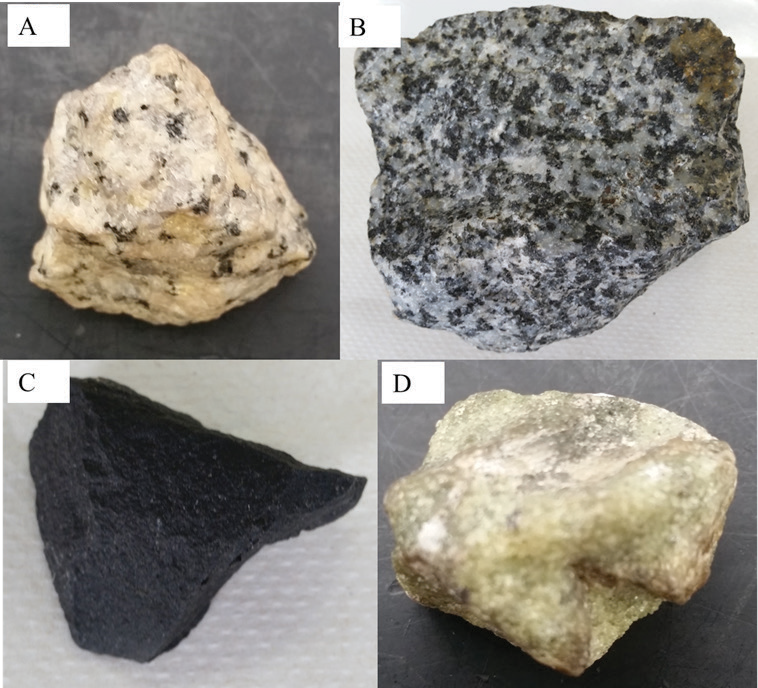
Source: Karen Tefend (2015) CC BY-SA 3.0 view source

Source: Karen Tefend (2015) CC BY-SA 3.0 view source
3.4 IGNEOUS ROCK TEXTURE
The classification of igneous rocks is based not just on composition, but also on texture. As mentioned earlier, texture refers to the features that we see in the rock such as the mineral sizes or the presence of glass, fragmented material, or vesicles (holes) in the igneous rock. We will cover mineral crystal sizes and vesicles in this section.
Since the crystals or phenocrysts form while the magma is cooling, then the size of the crystals must have something to do with the cooling process. The chemical elements that become part of the mineral must migrate from the liquid magma to bond with other elements in a certain way to form the unique crystal structure for that mineral. When magma cools slowly, the chemical elements needed to form a certain mineral have time to migrate; that mineral can become large enough to see without the aid of a microscope. This igneous rock is said to have a phaneritic texture (phan = large). The rock samples shown in Figure 3.2 are all phaneritic rocks; Figure 3.2A is a phaneritic mafic rock called gabbro, Figures 3.2B and 3.4B are a phaneritic intermediate rock called diorite, and the rock in Figure 3.2C is a phaneritic felsic rock known as granite. Magma that cools relatively quickly will result in a different rock; there is less time for the chemical elements to migrate and form large mineral crystals. Therefore, many small, microscopic crystals of a particular mineral will form; these igneous rocks are called aphanitic igneous rocks. Figure 3.4A and 3.4C are aphanitic rocks; since Figure 3.4A is dark in colour, it is a mafic aphanitic rock called basalt, and the felsic rock in Figure 3.4C is called rhyolite.
There can be equivalent extrusive and intrusive rocks, which appear to different but are chemically identical. For example, basalt and gabbro are both mafic rocks and have the same composition, but basalt represents a magma that cooled fast, and gabbro represents a magma that cooled slowly. The same can be said for the other rock compositions: the felsic rocks rhyolite and granite have identical compositions but rhyolite cooled fast and granite cooled slower. The intermediate rocks diorite (Figure 3.2B) and andesite (Figure 3.4B) also represent magmas that cooled slowly or a bit faster, respectively. Sometimes there are some visible crystals in an otherwise aphanitic rock, such as the andesite in Figure 3.4B. The texture of such a rock is referred to as porphyritic, or more accurately porphyritic-aphanitic since it is a porphyritic andesite, and all andesites are aphanitic. Two different crystal sizes within an igneous rock indicates that the cooling rate of the magma increased; while the magma was cooling slowly, larger crystals can form, but if the magma starts to cool faster, then only small crystals can form. A phaneritic rock can also be referred to as a porphyritic-phaneritic rock if the phaneritic rock contains some very large crystals in addition to the other visible crystals. In Figure 3.5 are two porphyritic rocks: a porphyritic-aphanitic basalt, and a porphyritic-phaneritic granite.
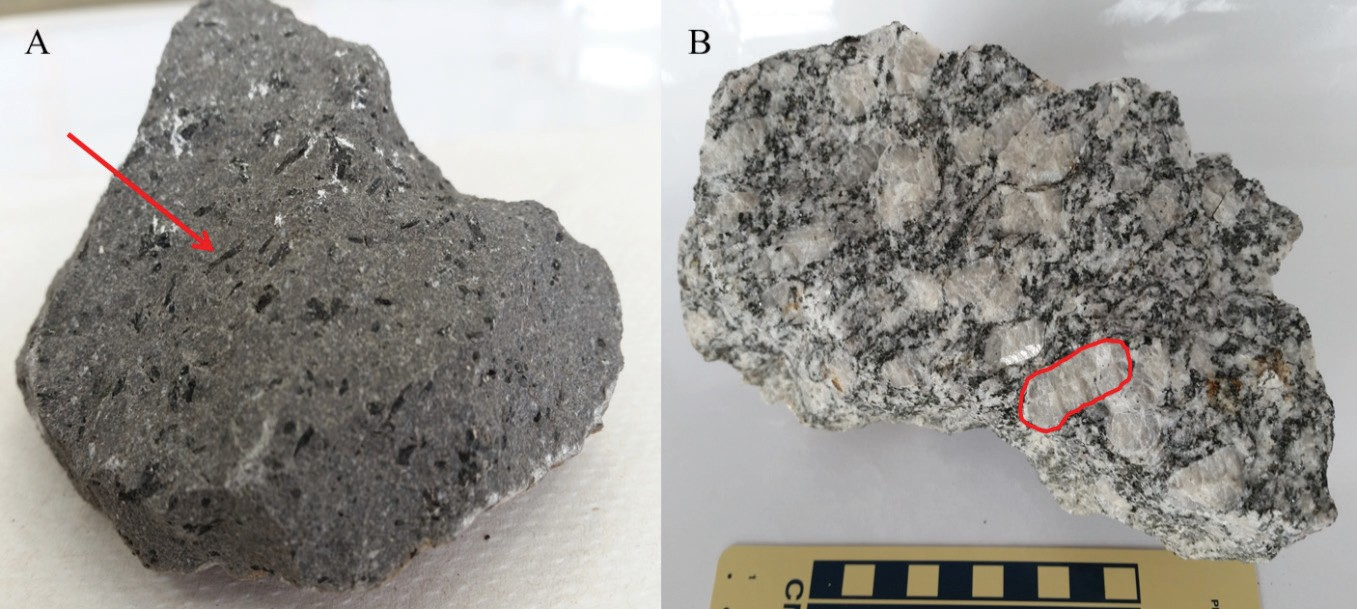
Source: Karen Tefend (2015) CC BY-SA 3.0 view source
Sometimes, the magma cools so quickly there isn’t time to form minerals, as the chemical elements in the magma have no time to migrate into a crystal structure. When this happens, the magma becomes a dense glass called obsidian (Figure 3.6A). By definition, glass is a chaotic arrangement of the chemical elements, and therefore not considered to be a mineral; igneous rocks composed primarily of glass are said to have a glassy texture. The identification of a glassy rock such as obsidian is easy once you recall the properties of glass; any thick glass pane or a glass bottle that is broken will have this smooth, curve shaped pattern on the broken edge called conchoidal fracture. Even though obsidian is naturally occurring, and not man made, it still breaks in this conchoidal pattern. If you look closely at the obsidian in Figure 3.5A, you will see the curved surfaces on the rock. Obsidian appears quite dark in colour regardless of its composition because it is a dense glass, and light cannot pass through this thick glass.
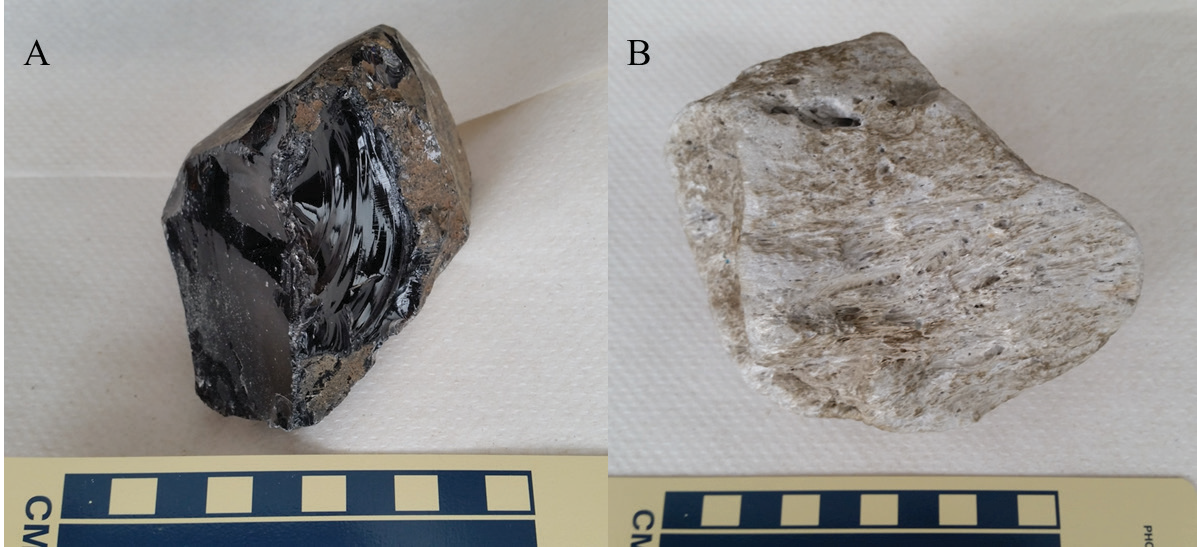
Source: Karen Tefend (2015) CC BY-SA 3.0 view source
In Figure 3.6B, there is another igneous rock that is also composed primarily of glass due to a very fast rate of magma cooling. This rock is called pumice, and is commonly known as the rock that floats on water due to its low density. The glass in this rock is stretched out into very fine fibers of glass which formed during the eruptive phase of a volcano. Because these fibers are so thin, they are easy to break and any conchoidal fractures on these fibers are too small to see without the aid of a microscope. Pumice can have any composition (felsic to mafic), but, unlike obsidian, the colour of the pumice can be used to determine the magma composition, as felsic pumice is always light in colour and mafic pumice will be dark in colour. Mafic pumice with a dark grey, red or black colour is also known as scoria.
3.5 IGNEOUS ROCK FORMATION—INTRUSIVE VS. EXTRUSIVE
The different crystal sizes and presence or absence of glass in an igneous rock is primarily controlled by the rate of magma cooling. Magmas that cool below the surface of the earth tend to cool slowly, as the surrounding rock acts as an insulator, which slows the rate of cooling. Magma that stays below the surface of the earth can take tens of thousands of years to completely crystallize, depending on the size of the magma body. Upon inspection of this rock, you would see that it is composed of minerals that are large enough to see without the aid of a microscope. Any igneous rock sample that is considered to have a phaneritic texture (or porphyritic-phaneritic), is referred to as an intrusive rock, as it is derived from magma that intruded the rock layers but never reached the earth’s surface.
If magma reaches the earth’s surface, it is no longer insulated by the rocks around it and will cool rapidly. Magma that reaches the earth’s surface through a fissure or central vent will lose some of its dissolved gas and becomes lava, and any rock that forms from lava will have either an aphanitic texture due to fast cooling, or a glassy texture due to very fast cooling. Flowing lava may continue to release gas while cooling; this is typical of mafic lava flows. If the lava hardens while these gases are bubbling out of the lava, a small hole or vesicle may form in the rock, the term “vesicular” is given to the rock to indicate the presence of these vesicles. For example, a basalt with vesicles is called vesicular basalt (Figure 3.7). These vesicles can be filled with a secondary mineral, such as quartz or calcite, long after the rock was formed; these filled vesicles are known as “amygdaloids”, giving an amygdaloidal texture (e.g. Figure 3.8).

Source: Karen Tefend (2015) CC BY-SA 3.0 view source

Source: Joyce M. McBeth (2018) CC BY 4.0 view source
Aphanitic rocks and rocks with a glassy texture are also known as extrusive igneous rocks, as the magma was extruded onto the surface of the earth. Porphyritic-aphanitic rocks are also considered to be extrusive rocks, as these rocks began crystallizing under the earth’s surface, forming visible crystals, but this magma later emerged onto the surface as lava, crystallizing to form an extrusive igneous rock with a porphyritic-aphanitic texture.
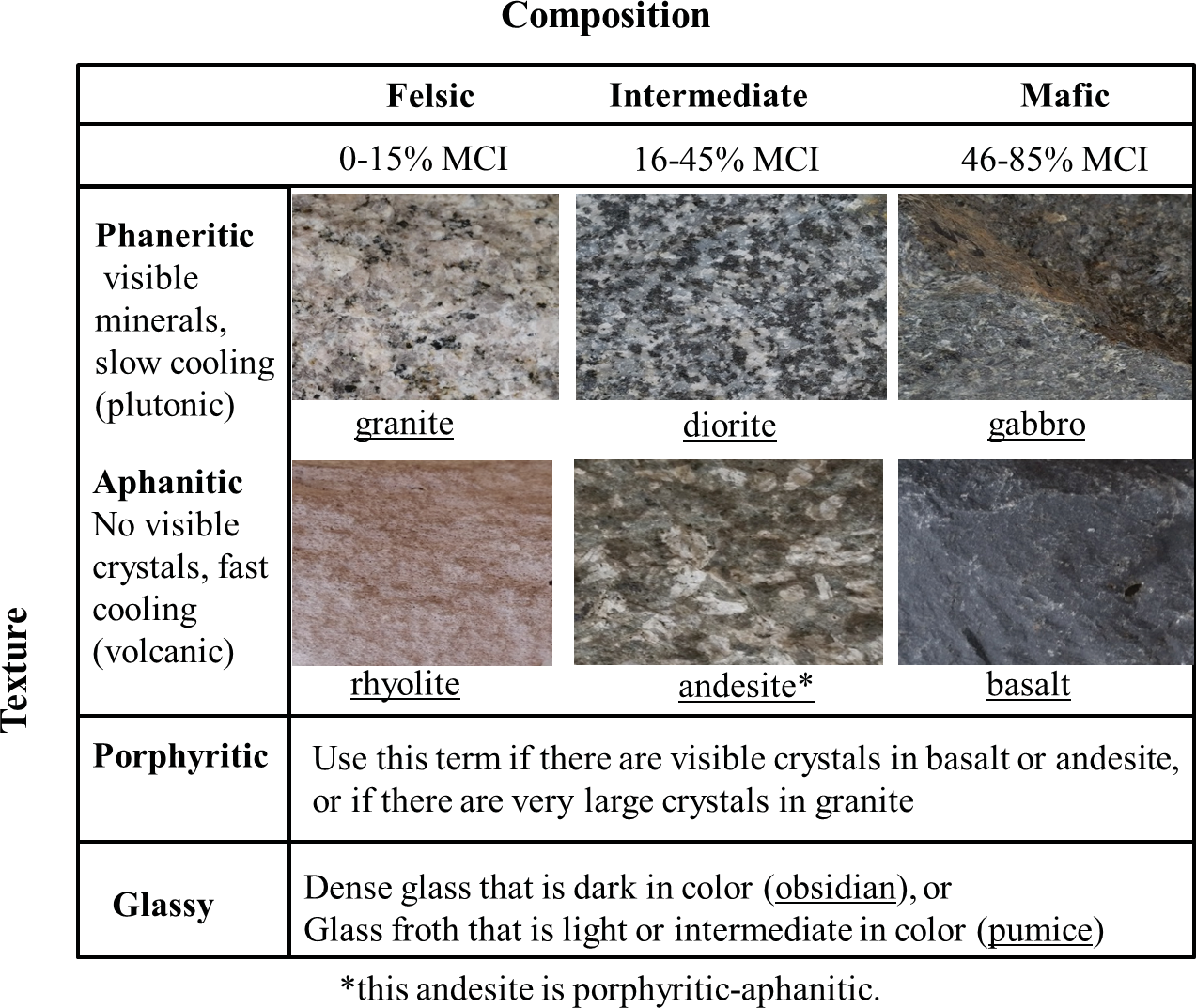
Source: Karen Tefend (2015) CC BY-SA 3.0 view source
A summary of the terms used to classify the igneous rocks are provided in Figure 3.9 in order to help with the identification of the igneous rock in this lab. Refer to the preceding figures for further help.

